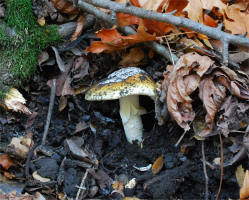
Unstaged specimen
in
(Beginner) Fungal Photography
(+Discussion/Suggestions)
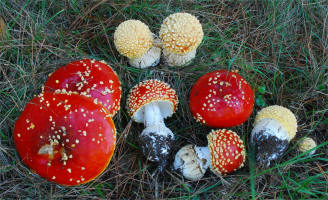
Staged specimens
| 1) BLURRED IMAGES.
This is the most common problem that renders many photos useless. It goes
beyond aesthetics, as many times the images are incongruent. Everyone
has fallen victim to it at one time or another. There are some main reasons
why BLUR occurs: a) FOCUS PROBLEMS. The main subject is not in focus -- easy to operate digital cameras make it a bit harder to tell the lens where to focus, particularly when shooting very small objects. Many times the background is in focus, but not the main subject. b) CAMERA SHAKE When shooting at slow speeds, or the hand of the photographer is too unsteady, the image will be blurred. This is more likely to occur with inexperienced shooters owning Digital SLRs and not paying attention to the combination speed/aperture. Using a tripod is best, but sometimes we do not have it and are required to shoot from hand. In such cases it may be Ok to open up the aperture to F5.6-F8 and gain speed while sacrificing depth of field. c) SHALLOW DEPTH OF FIELD -- see below, Problem 4. |
||||
|
| 3) POOR CHOICE OF COLLECTIONS Using old/damaged specimens or collections consisting of a single fruitbody for id purposes is not a good idea. Except in rare circumstances of absolute necessity, one should ignore such collections, Go find another one, or wait for a better opportunity. While true for most Genera, this rule is especially pertinent to Cortinarius where older fruitbodies simply cannot convey enough information that can be used for obtaining a good id. | |||
|
| 4) (TOO SHALLOW) DEPTH OF FIELD This one is trickier and presents questions even to more experienced photographers. A lot of blurring takes place when shooting mushrooms because the subjects are displaced quite much from the focus point. This is the primary driving force for Mushroom Photographers to use higher F-stops. But that requires longer exposure times. And that often requires that the camera is mounted instead of hand-held. Small, or long stemmed mushrooms present that challenge to a greater extent as there may be significant distance between all parts of the group that one is trying to capture. | |||
|
LIGHT RELATED ERRORS PHOTO + GRAPHY == LIGHT + SCRIBE
| 5) PHOTOGRAPHING MUSHROOMS IN DIRECT SUNLIGHT OR SHARP SHADOWS. This one is a classic and in the group of highly annoying errors. Everybody has tried to shoot things that are in direct sunlight. The results are awful. The amazing thing is that some people keep doing it over and over again, as if enjoying the poor results. Simple solution is to block the direct sunlight by some means -- photographers in the field can use their body or camera bag for such purposes. Be mindful of using clothing to block the sunlight, as it may let some light go through and usually reflects the color of the garment. A yellow shirt, for example, when used as a sun blocker will give yellow cast to the entire photograph. |
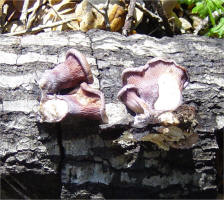 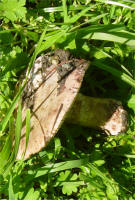 |
| 6) OVER/UNDER EXPOSURE The most common error is to see shots of big white mushrooms where most of the white surfaces are overexposed. The opposite is true too. Entirely black surfaces tends to naturally get underexposed and the camera settings need to be altered. Even the easy to use digital cameras allow the user to do "exposure compensation" when she feels it is appropriate. | ||
|
7) OVER RELIANCE ON FLASH Flash use is one of the most frequently
argued and yet quite confused subjects. A little flash definitely pulls out
some subtle colors that may be missed otherwise. But only when used in
moderation. Substituting flash power for longer exposure times, especially
in darker environments, produces terrible results that fall into two
main groups (see below, left and right).
|
||||||||||||||
| 8) POOR USAGE OF THE NATURAL LIGHT Natural light is a great asset. When properly used, that is. Sometimes, particularly early and late in the day the light come slanted towards the subject and tends to bounce off the horizontal surfaces. In other cases the underside of the mushroom may not gain advantage of light that is coming from behind. Here are a few examples of poor choice of natural light. | |||
|
| 9) SHOOTING UNDER INCANDESCENT LIGHT Most photos made indoors, under "yellow light" are unattractive and of limited use. Sometimes that's unavoidable like in foray/mushroom fair id tables. But if given a choice one should always strive to choose daylight. |
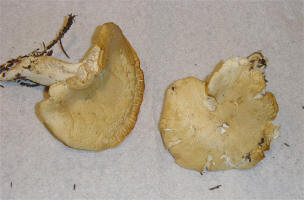 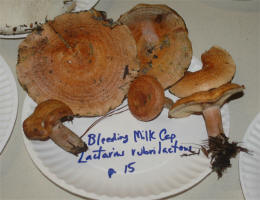  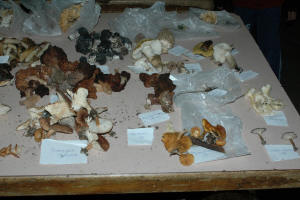 |
| PREFERENCES/SUGGESTIONS/THINGS TO
CONSIDER When reviewing this page with members of the MushroomTalk forum it appeared that the remaining subjects are more a matter of suggestions and preferences than hard necessities. Since the purpose of this page is not to pontificate matters to the extent of meddling with "personal taste", I leave these Sections as something just to "think about". |
10)
(POOR) CHOICE OF BACKGROUND. Finding a good background for a
mushroom photo requires some thought. Cleaning up the scene might be
important in many cases in order to have the main subject to contrast
nicely. Reviewing the photo helps too. Sometimes what seems like a bad
choice, is Ok, and vice-versa
|
| 11) HUMAN MATTERS -- BODY PARTS AND ARTIFACTS. The main motivation for including such in the photo is the desire to show scale. Yet, I agree with Nathan Wilson (MushroomObserver.org) and Ron Pastorino (SOMA) that the practice may create less than appealing photographs. In most cases, I believe that scale can be conveyed by well known natural objects, such as cones, leaves, etc. Here are a few examples, make your own choice. | |||
|
|||
|
| 12) 'IN SITU' vs. CONTROLLED ENVIRONMENT Darvin DeShazer (SOMA, Sci. Adv.) expressed the view that he likes the type of mushroom photography (Roger Phillips and others) where the collections are treated under controlled lighting and uniform background (affecting white balance). This kind of setup is typically indoor, or definitely away from the field. My view couldn't be more to the contrary of that, as I feel that 'In Situ' photography is far preferable. One concern that I have is that many mushrooms undergo color transformation once they are collected. The effects on the hygrophanous, as well as tiny and perishable species has to be dealt with too. Some mushrooms pale out as can be seen in books with that kind of photography. But this is also a matter of preservation technique apparently, as there are examples of excellent indoor photos. Yet, in general, I find such "controlled photos" lacking life, sterile and uninspiring, more like Lab specimens ("frogs in a jar"). I believe that the Natural habitat of the mushroom not only conveys a lot of analytical information, such as the habitat and location specifics, but also has a better artistic components. By setting certain mood, it allows us to enjoy the surrounding environment, which is a major reason for why we go out at the first place. It also helps us set mental notes on where we can find such mushrooms. | ||||||
|